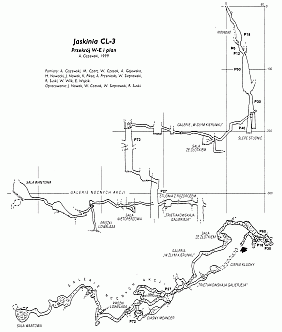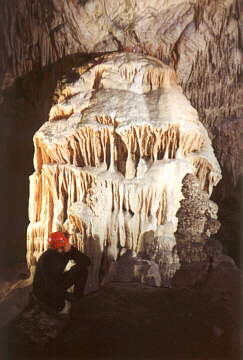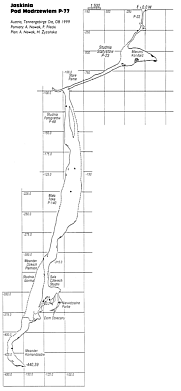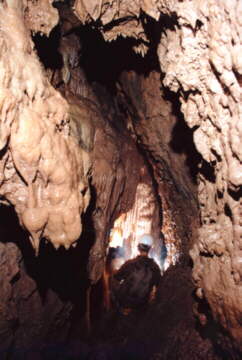


New entrance to Wielka Śnieżna
Finding a new entrance to Wielka Snieżna (biggest cave system in Poland, 22 km long, 814 m deep), in the Za Kolankiem (Beyound Knee) series has been attempted many times. Communication with surface was found at several places but none of them promised easy finding of an entrance. The most promising was the place were smoke appeared on surface when emitted in the so called Wilczy Ciąg (Wolf Passage) in the Za Kolankiem series. It was there when Wilcza Cave was discovered (54 m long) and finally communicated with the Za Kolankiem series. So a next, fifth entrance to Wielka Śnieżna has been found.
Climbing in Za Kolankiem series, photo: T. Sobański

Exploration behind Syfony Krakowskie sumps
Wiktor Bolek and Norbert Ziober dived through the Krakowski and Magdy sumps in the side series of Wielka Śnieżna. They found a series several tens of metres long with a water course flowing to the sumps. The streams have some waterfalls, the highest is 10 m high. This promising lead remains open for exploration. The discoverers named this series Dzikie Kaskady (Wild Cascades).

Autumn on the Kitzsteinhorn
At the end of September a small expedition of six (5 Poles and an Austrian) worked in the Kitzsteinhorn massif (the Hohe Tauren). They surveyed on the surface in order to precisely locate the discovered entrances.

CL-3 - Andrzej Ciszewski
As usual, an expedition led by Andrzej Ciszewski operated in the Leoganger Steinberge massif (Northern Calcareous Alps) in July and August. The goal was to extend upwards the Lamprechtshofen system - the world's deepest cave. Exploration began at -400 m in PL-2 (the highest part in Lamprechtshofen). As the place seemed of little promise, the team moved to CL-3, whose entrance lies 61 m higher than PL-2. Digging in blocks opened way to a series of pitches leading to -200 m. Wide galleries and pitches, mostly eastward trending, were then explored. In total more than 1.5 km of galleries have been discovered (mostly on -300 level) in CL-3 but they led in a wrong - not nonherly - direction. Kinderschacht (above PL-2) and Lodowa Jaskinia - 23 m above CL-3 - were also explored. Large dimensions of CL-3 passages give promise of extending system to the south to the close ridge of massif (200-300 m horizontally and 50-60 m higher), or to another side of ridge.


Banat '99 - Dariusz Bartoszewski
A group of cavers from Sopot, Wrocław, Kraków and Warsaw together with the Romanian club Exploratorü from Resita explored the Odobasnita zone in Romania. The massif culminates with the peak Virful Plesiva (1143 m) and is drained by several resurgences, the lowest of which lies at an altitude of 260 m. The massif is nearly completely covered with woods which makes exploration more diffcult The deepest cave discovered is Avenul Ioji (80 m deep, 154 m long). Diving in resurgences and low-lying caves was also done. The most interesting object for diving appeared to be Captare cave.

20 years in Eastern Tennen - Marcin Furtak
Speleoklub Bobry - Żagan explores the Tennengebirge Ost for twenty years. Cave Czerwony Pająk (Red Spider - P-19) was deepened to - 397 m. Vast horizontal series, several hundred metres long, have been discovered at the depth of 100 m. The most interesting discovery of the expedition was Jaskinia pod Modrzewiem (P-77) in which the depth -440 was attained.

Three postcards from Mt Canin - Jarosław Rogalski
The author describes impressions from his summer (July and Autumn break) expedition to the Mt Canin. A team of fifteen, led by Marek Kozioł explored in Complesso del Foran del Muss. Two new entrances to this system were discovered (23th and 24th). Moreover, a survey was done to locate entrances on the surface and a promising cave was discovered - Loch Kozicy - 110 m deep and 368 m long.

Cave no. 3 in the Nowy Wierch - Peter Magdolen
Situated in the Nowy Wierch Jaskyna vo Vrchu Novy c. 3 (Belanske Tatry, Slovakia) has been known for very long time. In the past century it was mentioned in a paper by Samuel Roth. A survey of its main series was made in the fifties. Cavers from Bratislava and Plavecke Podhradie resurveyed the cave in fall 1995 and in summer 1999. They discovered several hundred metres of new galleries and four new entrances in another valley then the entrance hitherto known. The cave totals now 582 m in length and 53 m of vertical extent.

Salty attractions in Romania - Stanisław Kotarba
The author visited abandoned salt mines in Romania, now open for tourists. One of them is Salina Veche Turda where salt exploitation began in 1690.
Caves of the Kilanowska Gora in the Beskid Niski - T. Mleczek
The Kilanowska Gora lies in the Beskid Niski (Flysch Carpathians) and is built mainly of thick-bedded sandstones. Fifty nine caves of total length of 940 m were found there. The longest of them - Gangusiowa Jama - is 190 m long. All the caves are non-karstic. Their origin is linked to rock-sliding, a common phenomenon in the area, and are related to intense exploitation of sandstone in nearby quarries.

Wojcieszów - the calcified problem - Marcin Furtak
The author describes the problems related to the exploatation of marble in the Połom quarry (the Sudetes). New caves are being discovered and destroyed during exploitation. The owners ban the cavers fair access to the caves.

Trainer's glimpse - Wojciech Radecki
The author describes rescue techniques training in Wieliczka Salt Mine. About 50 persons from all Poland took part in exercises.
Editors:
Jacek Duleba, Krzysztof Baran, Andrzej Ciszewski, Michal Gradzinski, Piotr
Kulbicki, Wojciech Radecki, Mariusz Szelerewicz
This HTML-version: Dariusz Bartoszewski
Editioral address (main):
ul. Ehrenberga 36a 31-309 Krakow, Poland e-mail: szelerewicz@ceti.pl
Internet edition:
e-mail: dbart@panda.bg.univ.gda.pl
WWW: panda.bg.univ.gda.pl/~dbart
 |
BACK to index |
 |
EPIMENIDES polish speleo page. |
Last change 2000.01.05